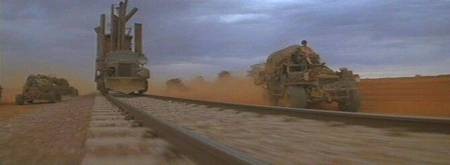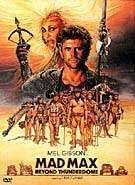George Miller's Mad Max III - Beyond Thunderdome
Mad Max III
Beyond Thunderdome

by, LES TURNER
Fan reaction to the third Mad Max film is a little varied. Some like it, some don't. I have mixed feelings about the film, sometimes I think it is a better film, and then sometimes I refuse to even admit that there was a third Mad Max film even made. Either way, the film was a success, and tells another story, and shows another side, of Max.
The film is set some time after the second, and we first find Max riding a wagon being drawn by camels. He is knocked off of this by bandits, and is left for dead in the dessert. He wanders upon Bartertown, a town full of dregs in the middle of nowhere. Max's stuff is being sold by the thieves, Jebediah and his son (Jebediah is played by Bruce Spence, the same Bruce Spence who played The Gyro Captain in Mad Max 2. But there is no mention of them being the same character).
Max is recognised as a strong willed man and is offered a proposal by the ruler of Bartertown, Aunty Entity. She wants him to fight in Thunderdome, and kill the reigning champion Blaster. The reason? Because there is a little powerstruggle gong on between Aunty Entity and MasterBlaster (Master is a midget who rides on the back of Blaster). If Max does this he will get all of his stuff back.
So Max agrees and we find ourselves in Thunderdome. A big arena in which two men fight to the death The rules are... there are no rules, anything goes. Including the various weapons that are hanging around the dome.
So Max and Blaster fight, Max almost kills him, but then finds out that Blaster is actually a retard, so Max refuses to finish him off. Aunty Entity sees this as a betrayal on their agreement, and the law is "Bust a deal, face the wheel" (Thunderdome created many famous quotes including the often heard "Two Men Enter. One man Leaves")
Max is banished to the wasteland to die. In the wasteland he is found by a group of kids who mistake him for their lost leader. Max gets quite comfy in their little 'Crack in The Earth', so when talk turns to trekking across the desert to find something better, Max tries to stop them. They go anyway, so Max has to chase after them because he knows that without his help they will surely die. They all get back to Barterwotn, and a big car chase follows with Max and the kids on a run away train, and Aunty and her henchmen on lots of post-nuclear cars ala Mad Max 2. Basically the film ends with Max having to decide to save himslef, or help the kids escape in a plane.
Probably the greatest scene in Thunderdome, is the fight in Thunderdome itself. Max battling it out with a big guy clad in armour, both are hooked up on big bungee cords. when you consider that every second film made nowadays has a fight scene with people on wires, it shows how far ahead of his time a filmmaker George Miller really his. Also compare this fight scene to the final scene of Babe 2, they are quite similiar. George knew he was onto something good, so he used it in another film.
Also a great scene is the ending in which we fly through a post-apopalyptic Sydney, Australia. As someone who has grown up, and lived his entire life in Sydney, it is quite surresl to see the city you love devastated by a nuclear bomb. The shell of the Opera House. Only half of the Harbour Bridge. These are truly haunting images.

The Yhunderdome Train
George Miller: ON THE STORY
" In my mind, it’s now about 15 years later. In that time, I imagine, he’s had a number of adventures and has basically survived them all. As resources have diminished, he’s probably built up his capital, which is his wagon train (Note: Max’s caravan stolen by Jedediah the pilot at the beginning of MM3, composed by the famous Junk Truck + a bunch of wild camels). He collect things, find things, is resourceful enough to improvise. By the start of this movie, there’s no fuel, so he just scavenges about finding things necessary to survival. Essentially, he’s a prince of his particular world and someone who has survived very well in it. He can defend himself if anyone, by and large, tries to take things away from him. The main lesson I think he learned from THE ROAD WARRIOR was that no man is an island, that you can’t help but be involved in the community of men, and he particularly learns this in the third picture. One of the main reasons we did this film was to get the opportunity to really push the character a lot further. He undergoes a much bigger journey in this pictures."
GEORGE MILLER: ON BARTERTOWN
"Bartertown is, even though it’s set in the future, really medieval. So it’s a very feudal place, a walled city ruled by physical power with law and order, but for the common good because it’s certainly better than what was before. It represents the kind of world in which you have to make your own way, you have to make a buck to live, to bring up a family or whatever. It’s fairly immediate, venal, profane, and it’s got a lot of humor in it. Bartertown is New York, Los Angeles…it’s like any city."
GEORGE MILLER: ON AUNTY ENTITY
" (Aunty) was probably the leader of a gang. She saw it was pretty futile to go across the landscape like locusts eating everything up, because eventually there’s nothing regenerated. So she says: ‘Instead of killing this man who’s trying to grow wheat or breed cattle, why don’t we protect him so he can harvest another crop next year ?’ So a bartering system developed. She also had to have great intelligence and be a POSITIVE rather than a DARK character --- not just a melodramatic bad guy. While writing the script we kept saying that ENTITY had to be someone like Tina Turner, but not specifically Tina Turner. When it finally came to casting, some months later, we said: ‘Why not TINA TURNER ?’ When I first called
Roger Davies (Turner’s manager) - he’s Australian, coincidentally - I said: ‘I’d like to talk to you about Tina doing the third Mad Max film.’ He laughed and said: ‘You know, Tina said to me yesterday she’d like to do a film something like THE ROAD WARRIOR. "
GEORGE MILLER: ON THUNDERDOME
" It’s a combination of circus, religious spectacle, and the Super Bowl…the people of Bartertown love Thunderdome, because it’s a good time. Yet it’s quite serious, too. It’s not a joke. The Thunderdome’s elastic bungeys were inspired by infants’ jolly jumpers. (It) makes a much more interesting fight than just going out on the ground with swords. "
GEORGE MILLER: ON THE LOST CHILDREN
" There wasn’t anywhere else for the story to go. We, in fact, were talking about another screenplay at dinner one night in a restaurant. We were just chewing the fat, and Terry (Hayes, co-screenwriter/co-producer) started to talk about a tribe of lost kids. I said: ‘Do you know you’re telling me the beginning of MAD MAX III ?’ We kept on chatting through the night until we evolved what was to become MAD MAX BEYOND THUNDERDOME. Because they’re children, they represent nothing but hope, which gives the film great optimism. Children have this belief that things can be better. So while we see a destroyed world (at the end of the film), they see something quite magical, quite divine. A story like this allows you to try to understand this fairly complex world, and to make a simple little parable. "
GEORGE MIILER: ON MAX'S DEATH
"We thought for a while that Max’s death might happen in this picture, but it just didn’t play in the story somehow. In fact, we went from the idea of him dying, to him disappearing and no one knowing what happens to him, and finally to the ending we have. But Max is a character who could die. "
GEORGE MILLER: ON THE TRILOGY
" As a filmmaker and storyteller, I think Max allows me --- or the films allow me --- to go almost anywhere. But they’re not fantasy films as such. Everything, by and large, is based in reality, except it’s set in some future which allows me to play around with it quite a bit. It’s much easier to get into these stories --- you have more fun with them, in a sense, because you’re not restricted."
Facts
Mel Gibson is listed as both actor and stuntman in Mad Max: Beyond Thunderdome
From,
http://members.optushome.com.au/lesturner/thunderdome.htm